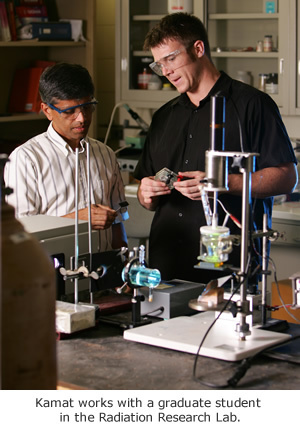
Prashant Kamat’s fundamental research, focused on how semiconductor nanostructures interact with light has sparked exploration aimed at a potentially game-changing solar paint that could generate electricity on any rooftop or home siding.
Development of the paint, using metal chalcogenide coated titanium dioxide particles, is in the early stages, but researchers have achieved efficiency of 1 percent to 2 percent. Given the vastly larger area for painting, Kamat says the material should be at least 5 to 10 percent as efficient. Researchers also must find ways to collect and transport electrons to counter electrodes in an efficient way.
“Right now it is not a marketable product,” he says. “It is only a proof of concept. We are looking for more partners. It will take another two to five years to develop a product out of this concept.” The paint would be a transformative technology, Kamat says, eclipsing silicon solar cells in the way thumb drives buried floppy disks and smartphones replaced landlines.
The development is an example of potentially beneficial and commercial applications flowing from the laboratory’s leading research on nanostructures and energy conversion, with support from the Department of Energy, the Center for Sustainable Energy at Notre Dame (cSEND) and the Strategic Research Initiative.
“This came as an offshoot of the main project,” Kamat says. “The main project is still fundamental understanding of how to make nanostructures useful for next generation solar cells. That is going very well. We publish very high-impact papers. They have been very well received by the scientific community. We are the leaders in this area, generating new ideas and showing how we can make better solar cells. Better understanding of how things work in these new light harvesting assemblies is very important for further development of solar cells.”

The laboratory includes about 15 graduate students, undergraduates, postdoctoral associates and visiting international scientists working on projects in four areas—artificial photosynthesis, quantum dot solar cells, carbon nanostructure architectures, and solar fuels such as producing hydrogen and reducing carbon dioxide.
“When it comes to energy, we need to consider three aspects—capture, convert and store,” Kamat says. “Quantum dots are semiconductor nanocrystals with size-dependent electronic and optical properties. We try to capitalize on these properties in improving the performance of quantum dot solar cells. We study both fundamental aspects to establish what happens when the light strikes the nanomaterial and how it transfers electrons.”
US Nano, started last year in Innovation Park, aims to help move such ideas into products, including writing large grant proposals for development.
The potential sources of energy are limited to earth’s heat, water tides, fission fuels, and solar energy, both stored (in fossil fuels, for example) and currently coming from the sun—enough in an hour, if we could capture it, to meet humanity’s needs for a year, he says: “It’s ‘Sun-Believable.’ You have to have that can-do approach rather than trying to find an excuse not to do these things.”